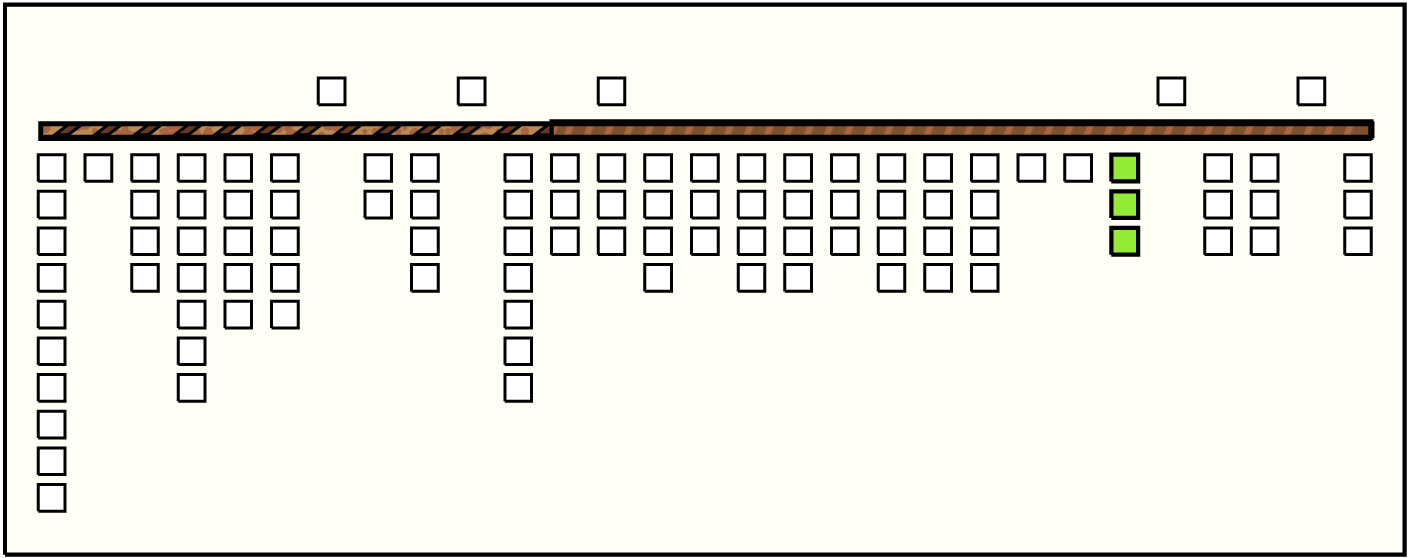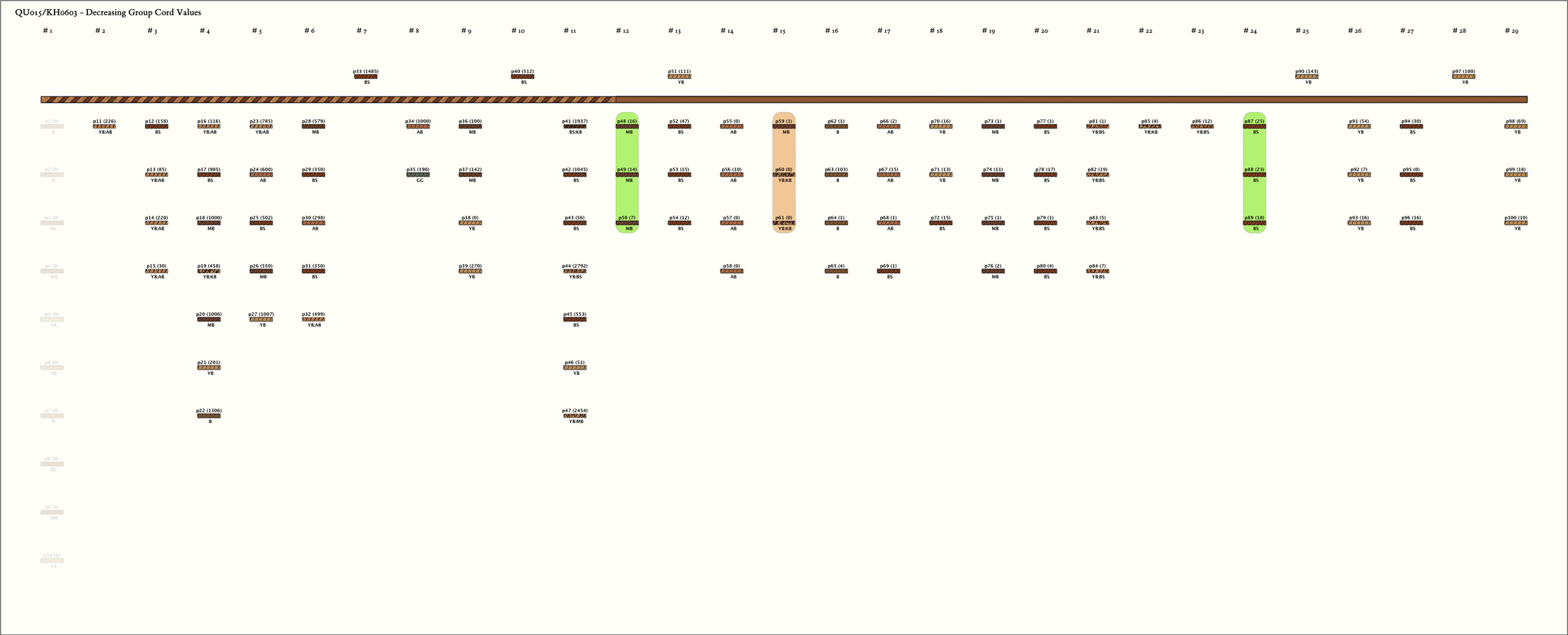QU015/KH0603 - Ascher Decreasing Groups
Drawings:
Ascher Decreasing Group:
Click on Image to View Larger
Individual Ascher Decreasing Groups: - Click on column name to sort
| # | Decreasing Group Schema | Group Position 1 Based Index |
# Cords in Group | Decreasing Cord Values |
|---|---|---|---|---|
| 0 |  | 12 | 3 | MB@[12, 1]:16 + MB@[12, 2]:14 + MB@[12, 3]:7 |
| 1 |  | 15 | 3 | MB@[15, 1]:1 + YB:KB@[15, 2]:0 + YB:KB@[15, 3]:0 |
| 2 |  | 24 | 3 | BS@[24, 1]:25 + BS@[24, 2]:23 + BS@[24, 3]:18 |
Khipu Notes:
Wise Khipu T41299.18 (B373)
Fragmentary khipu with two main cords and top and subsidiary and tertiary cords
Two fragmentary main cords interlocked to make one khipu.
Constructed of cotton and plant fiber with indigo dye.
Primary Cord
Main cord is made up of two different cords:
Main A - S-plied md br and mottled lt br/lt tn. Measures 19.7 in/50 cm from severed end to plied end
Perhaps put together without planning to from start; the main cords are tied together by looping end of Main B through ply end of Main A and then securing with a knotted P46.
Main B - S-plied striped blue and light brown, with two parts blue to one part lt br. Measures 15.4 in/39 cm from plied end to severed right end (with 1 in/2.5 cm of cord folded back in the intersection with Main A).
Two main cords are interlocked: Main B's plied end is pulled whole through the ply loop of Main A and then folded back over itself with the first pendant of Main B securing it to itself by tying around the main cord.
Main A is technically read "backwards" here in comparison to other khipu because it starts with the loose end on the left and ends with plied end on right.
Cord Notes
Some top cords in this khipu are pulled down on the mount -- could maybe be repositioned?
In A3, the subsidiary and tertiary cord knot values are possibly higher than the pendant knot sum (if we have assigned decimal position correctly) -- this is unusual.
In A8, the top cord value is 512, matching the sum of the associated, looped pendants of 512.
The sum of pendant cords on Main A (excluding those that may be broken) is 16829. The last group on Main A values 8888, and the rest of the groups in Main A are 7941.
It is possible that Groups A1-A8 originally valued 8888 in knots as well, making Main A two "sections" of 8888 and totalling 17776.
It is also possible that they were meant to be similar values that changed over time or depending on who counted whatever was being recorded and they are recorded together to show both.
However, there don't seem to be any color patterns duplicated in Group 9 that were present in the preceding groups.
There are none of the unidentified plant fibers on Main A, they are all on Main B.
A lot of broken cords on Main B that may alter our interpretation of the knot values and placements.
p81-89? have repeated color combinations and both produce knot sums of 143, but with different combinations of numbers.
First group of p81-89? has a top cord of 143 that matches the sum of its pendants knots; Next groups top cord is 100, but is broken, so could have also read 143.
Total knot sum of Main B is 661, meaning that the entire khipu has a pendant knot value of 17490, plus whatever knots were lost in the fragments.
A3's subsidiary cords are attached at the half-hitch knot, rather than on the body of the pendant.
Pendant 19 in A4 might be a top cord; it seems to "stand" rather than "hang."
Some subsidiary cords are attached through one strand of the plied pendants rather than around entire pendant.
Some strands of unidentified plant fibers.
Inverted long knot in Sub B1-49E.
P85 is not attached to the main cords; where did it come from?
Fragmentary khipu with two main cords and top and subsidiary and tertiary cords
Two fragmentary main cords interlocked to make one khipu.
Constructed of cotton and plant fiber with indigo dye.
Primary Cord
Main cord is made up of two different cords:
Main A - S-plied md br and mottled lt br/lt tn. Measures 19.7 in/50 cm from severed end to plied end
Perhaps put together without planning to from start; the main cords are tied together by looping end of Main B through ply end of Main A and then securing with a knotted P46.
Main B - S-plied striped blue and light brown, with two parts blue to one part lt br. Measures 15.4 in/39 cm from plied end to severed right end (with 1 in/2.5 cm of cord folded back in the intersection with Main A).
Two main cords are interlocked: Main B's plied end is pulled whole through the ply loop of Main A and then folded back over itself with the first pendant of Main B securing it to itself by tying around the main cord.
Main A is technically read "backwards" here in comparison to other khipu because it starts with the loose end on the left and ends with plied end on right.
Cord Notes
Some top cords in this khipu are pulled down on the mount -- could maybe be repositioned?
In A3, the subsidiary and tertiary cord knot values are possibly higher than the pendant knot sum (if we have assigned decimal position correctly) -- this is unusual.
In A8, the top cord value is 512, matching the sum of the associated, looped pendants of 512.
The sum of pendant cords on Main A (excluding those that may be broken) is 16829. The last group on Main A values 8888, and the rest of the groups in Main A are 7941.
It is possible that Groups A1-A8 originally valued 8888 in knots as well, making Main A two "sections" of 8888 and totalling 17776.
It is also possible that they were meant to be similar values that changed over time or depending on who counted whatever was being recorded and they are recorded together to show both.
However, there don't seem to be any color patterns duplicated in Group 9 that were present in the preceding groups.
There are none of the unidentified plant fibers on Main A, they are all on Main B.
A lot of broken cords on Main B that may alter our interpretation of the knot values and placements.
p81-89? have repeated color combinations and both produce knot sums of 143, but with different combinations of numbers.
First group of p81-89? has a top cord of 143 that matches the sum of its pendants knots; Next groups top cord is 100, but is broken, so could have also read 143.
Total knot sum of Main B is 661, meaning that the entire khipu has a pendant knot value of 17490, plus whatever knots were lost in the fragments.
A3's subsidiary cords are attached at the half-hitch knot, rather than on the body of the pendant.
Pendant 19 in A4 might be a top cord; it seems to "stand" rather than "hang."
Some subsidiary cords are attached through one strand of the plied pendants rather than around entire pendant.
Some strands of unidentified plant fibers.
Inverted long knot in Sub B1-49E.
P85 is not attached to the main cords; where did it come from?
